Contents
63% of students in the U.S. choose to study online because it aligns with their current life and work responsibilities, according to Bay Atlantic University. The number of such students increases every day.

Online learning is a way for students to forget about the need to spend time attending school physically. Online learning provides all the necessary knowledge virtually and gives students more freedom. Let’s break down online learning in more detail so even beginners can understand it.
What Does Online Education Include?
Online education mirrors traditional learning processes closely but comes with its own unique features. Let’s look at the key differences:
- All interaction takes place in the digital world. Students connect with classmates and teachers through platforms like Zoom
- Students use a reliable internet connection and equipment to avoid any issues
- There are fewer opportunities for physical interaction, and extracurricular activities are usually virtual
- Online learning requires strong self-discipline and more parental involvement
- All sessions are recorded, so students don’t have to worry about missing something if they can’t attend a class
- Online schools accept students from around the world, providing children a unique cultural experience. It also requires kids to be more mindful of each other
What Are the Pros and Cons of Online Education?
“One of the biggest aspects that stood out was that it was 100% online. It allowed for flexibility. I wouldn’t need to take time off work for classes or request a schedule change again”
Lauren Dohr, Arizona State University

Online education offers many advantages but also comes with challenges. The good news is all of these problems can be overcome. We looked at the pros and cons in detail in this article. We explained how to overcome the problems of online education in this article.

How Does Online Education Work?
Learning online becomes easy once you understand the processes. Let’s take a look at the main processes of online education.

Finding a Good Online School
Selecting an online school isn’t a direct part of the learning process, but it’s an important step for parents to find the right education for their children. Parents use websites like Niche to evaluate different online schools. This analysis is especially important if children have special needs and require personalized approaches. Comparing schools helps parents find the one best meeting their criteria.
Enrollment in an Online School
Each online school has its own unique features and may differ in its enrollment process. We covered how the general enrollment process looks in this article.
Accesses
Online learning takes place in the digital world. Parents and students receive access to the online platform and other web resources used for learning after signing a contract with the school. Family members assist students in checking everything is working correctly. Parents help students if something isn’t set up properly or reach out to the school’s support team for assistance.
Online Curriculum and Class Recordings
One major advantage of online learning is having all information just a few clicks away. Students access the curriculum online and have a clear view of what to expect in their upcoming lessons. Students catch up easily if they miss a class, as the lessons are recorded and uploaded by the teacher.
100% Virtual Interaction
All classes and student activities take place in the digital world. Students use WhatsApp, Trello, and other applications for interaction and completing assignments. This benefits students with special needs and introverted students. They don’t deal with bullying and other problems. Parents need to arrange physical activities for students outside of school.
Support is Always Near
Support in online education is available all the time. School support specialists are ready to assist parents and students at any time, day or night. These specialists help families with technical and other issues.
What Should Parents Consider When Their Child Switches to Online Education?
Transferring to a new school is a significant change. Most changes in our lives are associated with stress. We discussed the specifics of transitioning to online education and how to make it a smooth experience in this article.
How Does Online Learning Work at Legacy Online School?

Legacy Online School has been providing educational solutions to students around the world for several years. Our school is accredited by the Western Association of Schools and Colleges (WASC). The diploma from Legacy Online School is widely accepted.
Legacy Online School offers modern, innovative learning for kindergarten, elementary, middle, and high school students. Students choose the learning option suiting them best. Students learn at their own pace, in groups, or one-on-one with a live teacher. Tuition for online classes starts at $149 per month.
Legacy Online School has certified, skilled teachers from diverse cultural backgrounds. Many of these teachers have over 5 years of teaching experience, and some even more than 20 years.
The school offers a convenient platform for student learning and uses secure, reliable software for education. Studying at Legacy Online School is easy and enjoyable. School’s teachers and experts provide support to students and parents every step of the way.
Enroll in our school and give your child a brighter future!











